March 18, 2010 10:15 AM
September 23rd, 2008 11:23 AM
Falsity consists in the privation of knowledge, which inadequate, fragmentary, or confused ideas involve.
Spinoza, Ethics, Prop. II.35
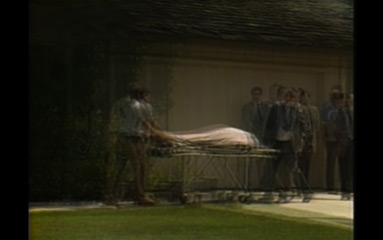
The Prior Patterns
I.
The concept of information appears to have first entered the literature of S-77 when ??????? started to discuss the "shift to simulation"—which [s]he referred to as "an unfolding fold" (Mip et al, 2007). Despite a 5-year intense activity devoted to the study of this "situation," there still remained a paucity of literature addressing the specific understanding of knowledge S-77 considered valid—and the semantic implications of using a different, "invalid" approach. Therefore, prior to discussing the communication procedures, the differences between knowledge and asynchronous balanced interpretations were outlined, circumpolarized, and clarified. […] A review of the literature was […] including: […] a new question (Kerr, 1999); […] refutation (???????, 2007), that […] varied, but the representations of which they were interpretations remained same.
II.
A confidential assessment published in 2012
by the Stereohell Research Council
described the following statement as "amplified."
I studied the Five Inside Down Pattern Problem [proposed in The Spurious Knowledge, Book II of stereohell, which demonstrates that a knowledge with a negative motion is not possible at any S- level] at S-77 in a hangar holed like a Zig-Zag cabinet where readings and experiments were conducted at industrial pace daily, organized into multiple overlapping experiments and readings designed to synchronize communication between other facilities. We were less than thirty “students” in constant relation with two supervisors and about ten guards adapting to their roles. We didn’t know exactly what was going on in the next hangars of the facility and the motives by which the activities were prompted were certainly ignored. Most of what we were offered for musing were “shadows.” One would witness a strange circumstance and would form conjectures. One would eat her meal and would smell the smell of a different meal. ?Or be given a mirror and asked to look into the pupils of her eyes and see an unfamiliar herself.? Or see a new entrant, male, taken from a room to a different room in another hangar to never be seen again–an event from which the euphemism “shadow” comes from. And knew that in one of the six other hangars people were taught to deny, because the theory was that one never unwillingly forgets anything, and of course some in my group thought that maybe that “ghost hangar” was our hangar but it was impossible to know if we were wrong or if we had forgotten.

One enigmatic individual omnipresent at S-77 knew more than us indubitably. She knew the things unknown and what was going on at S-77 and S-50, and probably S-22, but for reasons incongruous to logic never volunteered “intelligence” nor engaged in “rich” conversations, never made insinuations as to what her assignments were—that she effectuated placidly and that everyone was eager to interpret—, never banged her pink tongue nor clonked her palate in gratuitousness, except she droned to say no and knew all the usual civilities, the commonplace remarks, the accidental interjections, as if she were meant to not be, or operating undercover, or incapable of thinking the “three presents.” Her mystery, its depth, grandly augmented by the numbness of her behavior, excited endless curiosity and many frustrations, but questions slipped on the silence of her face. There was nothing to learn. One day she took me to hangar H. In a small room six files lay on a table. Someone determined to prove something had gathered notes, quotes out of context, “conclusions,” mostly relating to the circulation and accuracy of information—”generally speaking,” she said—from the five books of stereohell. She left me alone, without a word. I started to examine the files. The texts were short and fragmented. Everything was disarticulated. One document stated that “communications” undergo distortions, and depicted the mechanisms of such distortions as persistently evolving in capacity and speed, but there was a stable principle inherent to them that wasn’t. The principle was described in a separate file by a set of definitions and theorems supposed to deter misconceptions but I understood that the clear comprehension of the principle, how it structured its field of applicability and impinged askew on the surface of all things “shared” (communicated), and how it produced distortions, didn’t guarantee the full understanding and control of the distortions themselves, which were undeviatable and unflappable and continued to exist identical to themselves despite any comprehension thereof.
The next day I discussed the topic with William Gumm dit Billy Gumm, the Petrarca of Las Vegas, over gnocchi al zafferano, who the day before innocently brought to my attention a series of reports—commissioned by S-50 and S-22 (where he had been a guard for a semester), which administered S-77—, which outlined plans to emphasize experiments that mimic "critical" conditions and generate data to validate the "spurious knowledge" theory. He was chewing his buccal mucosa in agitated ignorance because it was a Wednesday, the day buses arrived, and distant entrants dressed in dark navy blue were progressing in file followed by sentinels and he was imagining that his brother was one of the entrants and in some sort of trouble. There is a vast knowledge, or ideas, I said, that we construe very well, only to understand, when hit by its reality, how useless it waxed. Because the body is stronger. I named disorders and passions like disease and sadness, possessiveness, and the useless knowledge we have of these well documented mechanisms and he, with his inordinate zeal and prelatic weaponery of yes and way to not contradict the way I presented things, and who usually employed nothing more than adjectives
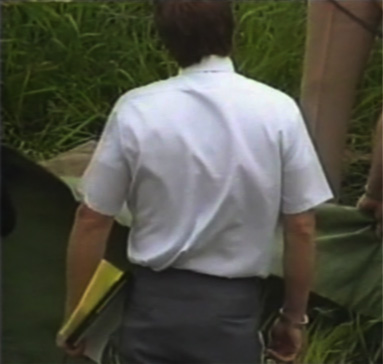
Rien n’advient, l’histoire ne se déroule pas:
on la découvre sous chaque mot, comme une présence
encombrante et obscène.
Nothing happens, the story does not unfold;
we discover it under each word,
like an obscene and obstructing presence.
Sartre, On The Sound and the Fury:
Temporality in Faulkner, Situations I, 1947
III.
Research on the application of the stereohell thesis as a tool has established the systematic appearance of rhetorical structures in spontaneous behavior, such as in the way tendencies to intimidate are combined into arguments, and arguments [verbosity] presented as ratiocination. We analyzed a set of data collected from 2007 to 2009 on subjects from colony S-77, whose behaviors followed cyclic Ruse-Denial-Apathy dynamics, and proved that their conveyance of candor was staged under the name of "interpretation." Furthermore, the results were relevant for the S-77 population dynamics as a whole. The experiments were brought to the cognizance of S-50 by Victor in 2010, in his official capacity as S-22 supervisor.
IV. Notes on Subject E, S-77
Patient ???????? had unusual abilities to elaborate complex situations coupled with a rare form of obduracy which [she] perceived as determinism. [She] transformed all situations as effects of external causes, regardless of their nature, until effects became causes. [She] ran circles around [her] and slummed her will into suppressed and "unintentional" intentions—where the context so admitted. We observed a calm expert of all things unjust and inevitable, whose principal occupation was to confiscate the forces of nuance and to derive, from this larceny, pride and grandeur.
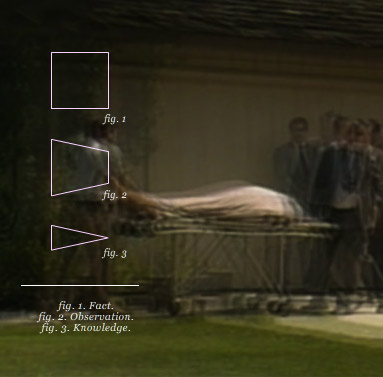
V.
[lines showing speed of communication
and mass of knowledge sloping upward exponentially]
The lunatic named Bobby Fisher “despised the media”: “They're destroying reality, turning everything into media.” “News exceed reality” writes Thomas Bernhard somewhere. The saturation and repetitions in Basquiat's paintings. The high-frequency trading. “an immense accumulation of nothing“ (Imp Kerr, 2009). An immense accumulation of ignorance. Parallels, folds, overflows. Differences.
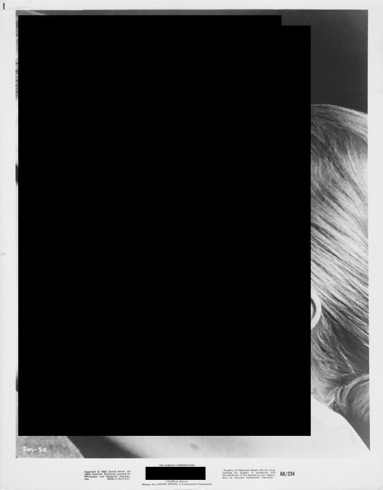
VI.
A phenomenon is an ensemble of elements in motion.
Nothing is infinitely immobile.
When not observed, phenomena do not exist as facts.
Facts are observed fragmentarily in their infinite continuance.
For each fact, there is an infinity of possible observations which change through its continuance.
An observation is a set of limitations.
By limitations we understand the variable causes of the deviations existing between a phenomenon observed and its observation. Henceforth the determination which characterized an observation is its limitations, which is to say that what is observed is always observed from a “point of view.”
A point of view is by direct effect an interpretation, thus an observation is an interpretation, one of many.
Observations are limited by the general limits of perception, and what is observed is always abridged.
A phenomenon always exceeds its observation.
Art is a coalescence of observations.
Art, like facts, creates knowledge.
An observation can be stored, or stored and transmitted.
A stored observation becomes knowledge spontaneously.
Knowledge is the communicable form of observations.
Knowledge is communicated through channels, supports, tools, agents, collectively called intermediaries, or media.
Media transmit and transform knowledge.
Technology enables people [initially non-media agents] to function as media.
A certain period of time always exists between the occurrence of a fact and the formation of its knowledge, and between the formation of a knowledge and its communication [mediatization] then reception. Such periods of time tend, inexorably, to diminish to near zero [approximate immediacy].
The speed of communication accelerates until it exceeds the speed of comprehension.
The number of media, which increases constantly, increases faster than the amount of significant knowledge available.
By significant knowledge we understand a first hand information, dissimilar from previous information, which has normative properties and establishes a precedent, which is derived from experience or science and only tends to express the certitude and singularity of a fact.
The mass of shared knowledge is proportional to the cost of communication and increases exponentially.
Saturation grows by definition, asymptotically nearing but not intersecting with infinity.
Saturation cannot be absorbed.
The growth of saturation mechanically enlarges the unbalance between facts and knowledge, and increases the mass of flawed and fictitious knowledge, insignificant knowledge, redundant knowledge, reiterated knowledge, unvalidated knowledge, inaccurate knowledge, fallacious knowledge.
Saturation of knowledge automatically engenders both uniformization and degradation of knowledge.
The mass of insignificant and inaccurate knowledge augments proportionally to and faster than the entire mass of communicated knowledge.
The possible mass of insignificant and inaccurate knowledge is infinite by definition.
There is a threshold where knowledge goes from significant to insignificant.
The significance of a knowledge is correlated to the extraordinariness of a fact, or of an observation.
Ordinariness, which is applicable to all types of observations regardless of their structure, is defined in terms of the normative concepts of both predictability and banality. An ordinary fact never engenders a significant knowledge, as never does ordinary art.
There is a threshold where knowledge goes from accurate to inaccurate.
Inaccuracy is applicable to the knowledge derived from standard observations solely.
Inaccuracy emanates from approximation and confusion, from misinterpreting imagination for understanding, or from a will to deceive.
From what precedes it necessarily follows that the inescapable future of knowledge is banality, falsehood, and overabundance, which sum is a form of ignorance.
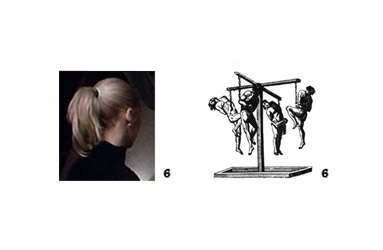
Appendix
a. More of the same
Brodkey, using the third person, always told the same story: He [Brodkey] got hired by New York investment banker Greg Freleng. Based on instructions from Freleng, he went to Las Vegas where he sold a pair of shoes to a journalist he claimed were worn by Billy Gumm, an employee of SpriteOne Resorts, known as Billy “The Eel” Gumm, at the time he was killed [murdered] [Gumm actually disappeared]. Brodkey’s initial target, short-circuited, was SpriteOne boss Tony Ritz, by way of Ricky Warm, whom Brodkey attained [ricochetly] in retaliation to the Ricky Warm is selling a fake Klimt stunt—following orders given by Ritz—to art dealer Kaiser Fritsh in New York, targeting his compeer Greg Freleng. Jerry Syrup [Director of Operations of SpriteOne Resorts], who owned a Revox open-reel tape recorder, two Tascam cassette decks, several Olympus microcassette recorders, two Nagra full track monophonic recorders, was asked by Ritz to wiretap Freleng. In a recording made on April 25, 2008, Freleng discussed, for the first time, his intention to buy shares of Kace Las Vegas (KLV), and said: “I spend far too much time making money, it’s a wonder it still turns me on.” It was understood that Freleng wanted to profit from the takeover of KLV. It was supposed to be entirely about “juicing” money out of the trade [insider trading event], but soon it slipped to vanity and revenge issues, and became the Ritz vs. Freleng case.
b. Additional case notes
Brodkey became obsessed with Imp Kerr after he discovered the online version [blog] of stereohell in [June] 2009. A man of immense meticulousness, he read the content of the blog 50+ times in a row and determined that the six diarists were actually one person using multiple personae. He concluded that this one person could only be Imp Kerr and that the girls working at Wax & Bobs from whom he had, since 2006, accepted torments, injunctions, and gobs of spit, were a simulation.
In a tape [numbered 67/03/10], Jimmy Brodkey talks to an unnamed caller. He confirms that all the girls were “under his surveillance” and says that "it was a question of circumstance," and that the writings were meant to protect the “case of someone."
For a short time [five months] he stalked Imp Kerr, taped her phone, installed a camera in her apartment, in her car [she didn't have a car], to discover, much to his denial, that the six diarists were, as a matter of fact, six different, living persons, that Kim Cooper did exist and was effectively Imp Kerr’s roommate and Freleng's subordinate, that Aloysia Covert did exist and was effectively Imp Kerr’s friend and Sybil Harper's girlfriend, and on. The findings eventually forced him to admit, reluctantly [tape numbered 35/03/10], the veracity of stereohell, to acknowledge what he had contradicted with ambiguities until he considered that despite consisting of an implicit [fallacious, tape numbered 42/03/10] reflection on truth and lie and the ideated frontier that separates the two, and enticing its readers to question its origination, and to wrap their confusion in an envelop of paranoia, and developing upon accounts of facts, nombrilisme, dispersed knowledge and mockeries, stereohell was a humble exhibition of profiles and personal experiences, reasonings and opinions, written in first-person diary entries by Imp Kerr and the five cross-mentioned girls, successively enrolled as it is narrated in chronological order, and which reputed malignity and teleology were non-existent.
